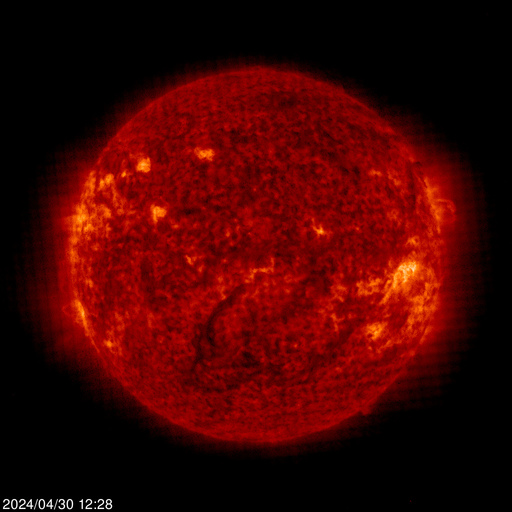SIDC Ursigram
3-day-forecast of solar and geomagnetic activity.| Source | SIDC (RWC-Belgium) |
| Frequency | Daily |
| Format | Encoded data (ISES) |
| Mail header | SIDC Ursigram |
| SIDC code | meu |
Archive
Latest issue
:Issued: 2025 Jul 02 1232 UTC :Product: documentation at http://www.sidc.be/products/meu #--------------------------------------------------------------------# # DAILY BULLETIN ON SOLAR AND GEOMAGNETIC ACTIVITY from the SIDC # # (RWC Belgium) # #--------------------------------------------------------------------# SIDC URSIGRAM 50702 SIDC SOLAR BULLETIN 02 Jul 2025, 1231UT SIDC FORECAST SOLAR FLARES : C-class flares expected, (probability >=50%) GEOMAGNETISM : Active conditions expected (A>=20 or K=4) SOLAR PROTONS : Quiet PREDICTIONS FOR 02 Jul 2025 10CM FLUX: 126 / AP: 024 PREDICTIONS FOR 03 Jul 2025 10CM FLUX: 124 / AP: 031 PREDICTIONS FOR 04 Jul 2025 10CM FLUX: 122 / AP: 024 Solar Active Regions and flaring: Solar flaring activity over the past 24 hours was low, with few C-class flares recorded. The largest flare was a C1.1 flare, peaking at 11:29 UTC on July 02, associated with SIDC Sunspot Group 513 (NOAA Active Region 4132; magnetic type alpha). There are currently ten numbered active regions on the visible solar disk. SIDC Sunspot Group 537 (NOAA Active Region 4126; beta) is expected to rotate over the west limb in the coming hours. Solar flaring activity is expected to be low over the next 24 hours, with C-class flares very likely and a small chance for M-class flares. Coronal mass ejections: No Earth-directed CMEs were observed in the available coronagraphic imagery over the past 24 hours. Solar wind: Over the past 24 hours, solar wind parameters (ACE and DSCOVR) reflected a return to slow solar wind conditions. The solar wind speed decreased from about 530 km/s to around 380 km/s. The interplanetary magnetic field remained below 7 nT, and its southward component fluctuated between -3 nT and 3 nT. Solar wind conditions might become slightly elevated over the next days due to the possible arrival of an ICME associated with a partial halo CME (SIDC CME 523), observed lifting from the Sun on June 28, and the anticipated high-speed stream arrival from the recurrent negative polarity coronal hole (SIDC Coronal Hole 111). Geomagnetism: Geomagnetic conditions were quiet globally and quiet to unsettled locally, over Belgium (NOAA Kp: 1 to 2, K-Bel: 1 to 3). Geomagnetic conditions are expected to remain at quiet to unsettled levels, with a chance of increasing to active conditions and isolated minor or moderate storm periods on July 02-03, due to the possible arrival of an ICME associated with a partial halo CME (SIDC CME 523) observed lifting from the Sun on June 28, and the expected high-speed stream arrival from the recurrent negative polarity coronal hole (SIDC Coronal Hole 111). Proton flux levels: The greater than 10 MeV GOES proton flux was below the threshold level over the past 24 hours and is expected to remain so for the next 24 hours. Electron fluxes at GEO: The greater than 2 MeV electron flux, as measured by GOES-18 and GOES-19, exceeded the 1000 pfu threshold over the past 24 hours. The greater than 2 MeV electron flux may exceed this threshold again in the coming days. The 24-hour electron fluence was at moderate levels and is expected to remain at moderate levels over the next 24 hours.
Zdroj : SIDC Ursigram |
Předpověď sluneční aktivity pro období : June 27 - July 03, 2025
Zdroj : http://www.asu.cas.cz/~sunwatch |
Poslední fotografie ze SOHO / SDO:
Různé barvy snímků prozrazují odlišné vlnové délky - každá
vlnová délka je vyzařována plynem o určité teplotě: oranžová: 80 000 °C,
modrá: 1 000 000 °C, zelená: 1 500 000 °C, hnědá: 2 500 000 °C.










